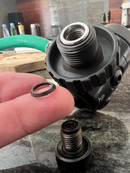trimmatters
Registered
Hey team
Ended up iwth a HOG D2 first stage as part of my transition to CC last year.
Have had issues with one of the o-rings getting mashed in the screw-in post from the DIN. See pic. Like, I can't get one to last more than 5-10 days of dving, if that.
The original o-ring, as purchased with the reg new for the course, lasted the 5 days of diving for the course, and one day of post-course diving before I started having to replace it regularly.
I have tried every material and slight size difference I can for this o-ring but they all keep getting mashed and dying. I've previously only seen this issue of that o-ring going for Apex first-stages but those o-ring sizes were known to my dive buddy.
The HOG dealer in Australia that did servicing etc has recently closed and that's where this one was purchased from. I'd love to do the HOG servicing course but in the mean time I'm kinda sick of having to replace the o-ring every 5-10 days of diving.
Any thoughts?
Ended up iwth a HOG D2 first stage as part of my transition to CC last year.
Have had issues with one of the o-rings getting mashed in the screw-in post from the DIN. See pic. Like, I can't get one to last more than 5-10 days of dving, if that.
The original o-ring, as purchased with the reg new for the course, lasted the 5 days of diving for the course, and one day of post-course diving before I started having to replace it regularly.
I have tried every material and slight size difference I can for this o-ring but they all keep getting mashed and dying. I've previously only seen this issue of that o-ring going for Apex first-stages but those o-ring sizes were known to my dive buddy.
The HOG dealer in Australia that did servicing etc has recently closed and that's where this one was purchased from. I'd love to do the HOG servicing course but in the mean time I'm kinda sick of having to replace the o-ring every 5-10 days of diving.
Any thoughts?





